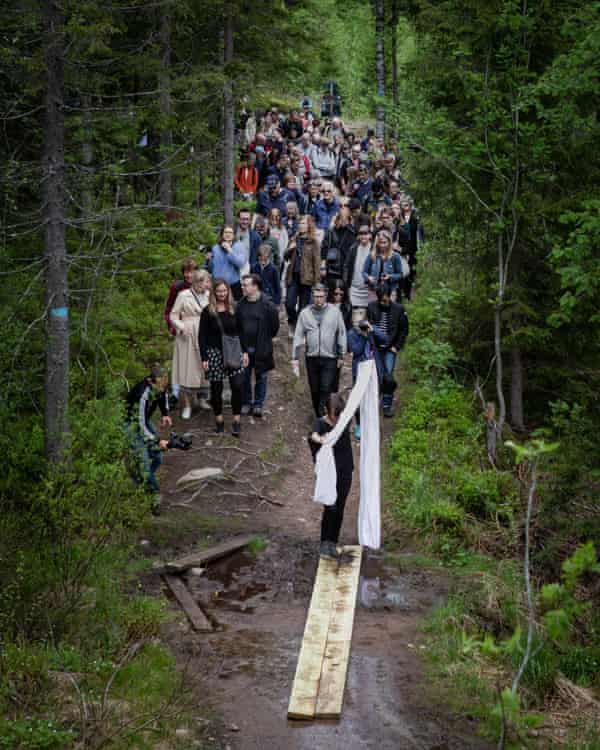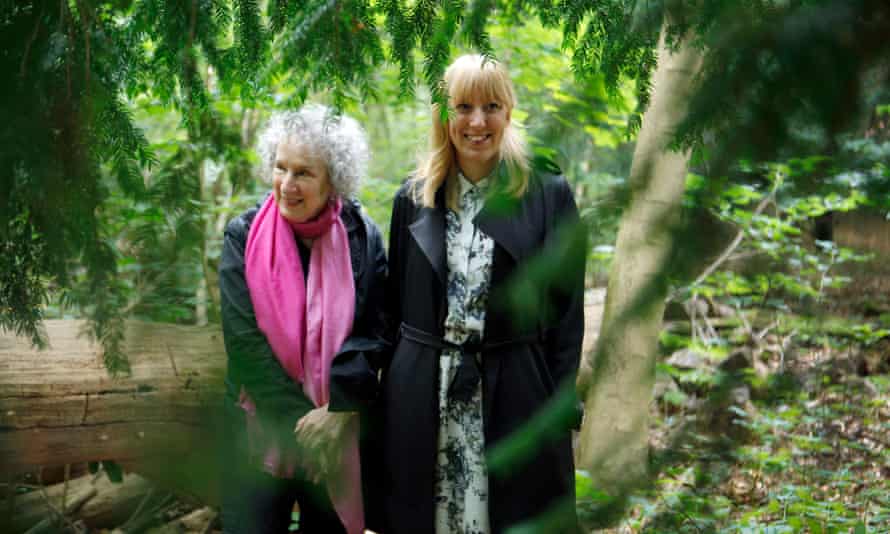Future Library opens secret archive of unseen texts in Oslo | Future Library
On Sunday the Future Library, a project dreamed up by the Scottish artist Katie Paterson, was opened to the public in Oslo. After eight years, manuscripts penned by some of the world’s most famous living authors were delivered to “The silent room” on the top floor of the Deichman library, where they will remain for the next 92 years.
Four of the Future Library’s eight authors travelled to personally slide their manuscripts into one of the 100 glass drawers in the room constructed from 100 layers of undulating carved wood. Visibly awed and clutching their manuscripts, David Mitchell, Sjón and Tsitsi Dangarembga lined up in stockinged feet – Karl Ove Knausgård was barefoot – to enter the womb-like treehouse and deposit their stories. These works will not be read or published until 2114, when the Future Library will open its drawers to the world.
Until that day, only small groups of visitors may sit shoeless and in silent contemplation of the growing family tree of authors surrounding them, trying to imagine what Elif Shafak or Margaret Atwood might have written for their future readers. In 2014, Atwood became the first author to take part in the project, which asks authors to write a text of any length or genre, but not to reveal anything about it except the title. The eight works that have now been written have fabulously tantalising titles, from Scribbler Moon (Atwood) to The Last Taboo (Shafak).
Atwood compared the project with Sleeping Beauty, remarking “how strange it is to think of my own voice – silent by then for a long time – suddenly being awakened after 100 years”. Neither Atwood, Shafak (2017) nor Han Kang (2018), could attend the grand 2022 reunion, made even more momentous by a three-year Covid delay. The three authors who joined the project in this time – Knausgård (2019), Ocean Vuong (2020) and Dangarembga (2021) – were all set to attend, but in a sad twist, Vuong had to pull out at the last minute after catching Covid. The On Earth We’re Briefly Gorgeous author had previously said that contributing to the Future Library was “the highlight of [his] career as an author and human being”.
Handover Day began with several hundred people accompanying the authors, artist and city officials on a trek through Oslo’s city forest to an elevated plain of young spruce, birch, aspen and rowan trees. In 2014, this area was cleared of enough mature trees to construct the silent room and planted with 1,000 spruce saplings. After 100 years, these trees will be felled to make the paper on which the 100 manuscripts that will have by then been archived will be printed. It is a project of magical, magnificent ambition, trust and hope – hope that there will be books, readers and forests in 2114.
Imagining that day, Mitchell quipped, “it will be like Woodstock in the forest!” Already, with dramatically growing audiences, spruce saplings and a roster of A-list authors, Future Library 2022 resembled a glittering green festival. Knausgård spoke simply and movingly about the privilege of participating, in spite of the unavoidable anticipation of death, adding: “The magic is to make the future present for us now. The future doesn’t exist, it’s what we make it.” He revealed the title of his contribution, Blind Book, before passing on to Dangarembga, who delivered her manuscript, Narini and Her Donkey. “In my country,” she explained, “Narini means ‘infinity’, like this project … I come from Zimbabwe, a troubled country at the moment, where people are looking back to the colonial era … I take issue with that.”

Finally, Ocean Vuong evoked something of Han Kang’s mesmerising 2018 handover ceremony, in which she dragged a long white cloth through the forest to represent birth and death, calling the project “a century-long prayer”. The crowd in 2022 felt the presence of the absent Vuong with – as was his wish – a chant by three Buddhist monks.
In the eight short years since its inception, because of the pandemic, growing concerns about the climate crisis and the war in Ukraine, the symbolism and mission of the Future Library – to provide hope for the future – feels more urgent. This was not lost on the first batch of authors, said this year’s special guests Sjón and Mitchell. Sjón described “this path here in the forest in Oslo (becoming) a metaphor for how literature works: it is the work of generations; writers are literally working in the footsteps of writers who went before them – and that is the magic of Katie’s work: she makes enormous concepts like time and the universe visible and understandable.”
Mitchell reflected on his 2016 handover: “I felt it was visionary, an act of stubborn optimism and very beautiful. If someone had started this in 1914 instead of 2014 and it was now finished, think of the people who might have contributed to it – James Joyce, James Baldwin, Eudora Welty! … So I took it very seriously.” He added that it’s been “wonderful to see the project snowball, gain momentum”, especially because of “these new, positive unintended consequences as a disseminator of global writing – I hadn’t seen that coming. Gathering together like this we are creating something new, a plantation.”
Sjón, who wrote his text in Icelandic, also derives comfort from the camaraderie of the Future Library authors but expressed concern that the “vulnerability of my language, spoken by only 370,000 people” might mean it might not survive or find translators in 2114. Whether or not you are remembered in future years is “always a test you face as an author”, he said. “You have to be an author of your own times and if your work is readable in 100 years then good for you; if not, you did your best, and maybe you are better off not knowing you will be read in 100 years!”
On Sunday the Future Library, a project dreamed up by the Scottish artist Katie Paterson, was opened to the public in Oslo. After eight years, manuscripts penned by some of the world’s most famous living authors were delivered to “The silent room” on the top floor of the Deichman library, where they will remain for the next 92 years.
Four of the Future Library’s eight authors travelled to personally slide their manuscripts into one of the 100 glass drawers in the room constructed from 100 layers of undulating carved wood. Visibly awed and clutching their manuscripts, David Mitchell, Sjón and Tsitsi Dangarembga lined up in stockinged feet – Karl Ove Knausgård was barefoot – to enter the womb-like treehouse and deposit their stories. These works will not be read or published until 2114, when the Future Library will open its drawers to the world.
Until that day, only small groups of visitors may sit shoeless and in silent contemplation of the growing family tree of authors surrounding them, trying to imagine what Elif Shafak or Margaret Atwood might have written for their future readers. In 2014, Atwood became the first author to take part in the project, which asks authors to write a text of any length or genre, but not to reveal anything about it except the title. The eight works that have now been written have fabulously tantalising titles, from Scribbler Moon (Atwood) to The Last Taboo (Shafak).

Atwood compared the project with Sleeping Beauty, remarking “how strange it is to think of my own voice – silent by then for a long time – suddenly being awakened after 100 years”. Neither Atwood, Shafak (2017) nor Han Kang (2018), could attend the grand 2022 reunion, made even more momentous by a three-year Covid delay. The three authors who joined the project in this time – Knausgård (2019), Ocean Vuong (2020) and Dangarembga (2021) – were all set to attend, but in a sad twist, Vuong had to pull out at the last minute after catching Covid. The On Earth We’re Briefly Gorgeous author had previously said that contributing to the Future Library was “the highlight of [his] career as an author and human being”.
Handover Day began with several hundred people accompanying the authors, artist and city officials on a trek through Oslo’s city forest to an elevated plain of young spruce, birch, aspen and rowan trees. In 2014, this area was cleared of enough mature trees to construct the silent room and planted with 1,000 spruce saplings. After 100 years, these trees will be felled to make the paper on which the 100 manuscripts that will have by then been archived will be printed. It is a project of magical, magnificent ambition, trust and hope – hope that there will be books, readers and forests in 2114.
Imagining that day, Mitchell quipped, “it will be like Woodstock in the forest!” Already, with dramatically growing audiences, spruce saplings and a roster of A-list authors, Future Library 2022 resembled a glittering green festival. Knausgård spoke simply and movingly about the privilege of participating, in spite of the unavoidable anticipation of death, adding: “The magic is to make the future present for us now. The future doesn’t exist, it’s what we make it.” He revealed the title of his contribution, Blind Book, before passing on to Dangarembga, who delivered her manuscript, Narini and Her Donkey. “In my country,” she explained, “Narini means ‘infinity’, like this project … I come from Zimbabwe, a troubled country at the moment, where people are looking back to the colonial era … I take issue with that.”

Finally, Ocean Vuong evoked something of Han Kang’s mesmerising 2018 handover ceremony, in which she dragged a long white cloth through the forest to represent birth and death, calling the project “a century-long prayer”. The crowd in 2022 felt the presence of the absent Vuong with – as was his wish – a chant by three Buddhist monks.
In the eight short years since its inception, because of the pandemic, growing concerns about the climate crisis and the war in Ukraine, the symbolism and mission of the Future Library – to provide hope for the future – feels more urgent. This was not lost on the first batch of authors, said this year’s special guests Sjón and Mitchell. Sjón described “this path here in the forest in Oslo (becoming) a metaphor for how literature works: it is the work of generations; writers are literally working in the footsteps of writers who went before them – and that is the magic of Katie’s work: she makes enormous concepts like time and the universe visible and understandable.”
Mitchell reflected on his 2016 handover: “I felt it was visionary, an act of stubborn optimism and very beautiful. If someone had started this in 1914 instead of 2014 and it was now finished, think of the people who might have contributed to it – James Joyce, James Baldwin, Eudora Welty! … So I took it very seriously.” He added that it’s been “wonderful to see the project snowball, gain momentum”, especially because of “these new, positive unintended consequences as a disseminator of global writing – I hadn’t seen that coming. Gathering together like this we are creating something new, a plantation.”
Sjón, who wrote his text in Icelandic, also derives comfort from the camaraderie of the Future Library authors but expressed concern that the “vulnerability of my language, spoken by only 370,000 people” might mean it might not survive or find translators in 2114. Whether or not you are remembered in future years is “always a test you face as an author”, he said. “You have to be an author of your own times and if your work is readable in 100 years then good for you; if not, you did your best, and maybe you are better off not knowing you will be read in 100 years!”
